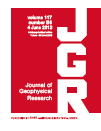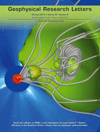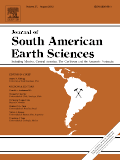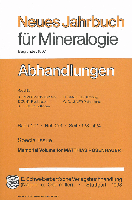
JOURNAL OF GEOPHYSICAL RESEARCH-SOLID EARTH
Scope & Guideline
Unveiling Earth’s Secrets Through Rigorous Research
Introduction
Aims and Scopes
- Tectonic Processes and Earthquake Mechanics:
Research in this area includes the study of fault dynamics, rupture mechanisms, and the stress state of tectonic plates. It aims to understand the processes that lead to earthquakes, including both natural and induced seismicity. - Volcanology and Magmatic Systems:
This scope covers the study of magma generation, transport, and eruption processes. It includes research on volcanic activity, caldera dynamics, and the interaction of magmatic systems with tectonic structures. - Geophysical Imaging and Modeling:
The journal publishes studies utilizing advanced imaging techniques such as seismic tomography, ambient noise analysis, and magnetotellurics to investigate the structure and properties of the Earth's crust and mantle. - Hydrogeophysics and Fluid Dynamics:
Research focusing on fluid movement within geological structures, including groundwater flow, hydrothermal systems, and the impact of fluid pressure on fault mechanics. - Paleomagnetism and Geochronology:
This area examines the historical magnetic properties of rocks to understand tectonic movements and changes in the Earth's magnetic field over geological time. - Geochemical Processes in the Earth's Interior:
Studies in this scope analyze the chemical composition of rocks and minerals, including the behavior of volatiles and the implications for mantle processes and crustal evolution.
Trending and Emerging
- Machine Learning and AI Applications:
An increasing number of studies are utilizing machine learning techniques for data analysis, seismic event detection, and predictive modeling, reflecting a growing trend towards integrating artificial intelligence in geophysical research. - Induced Seismicity and Hydrocarbon Extraction:
Research focusing on the effects of hydraulic fracturing and other anthropogenic activities on seismicity is gaining prominence, addressing public concerns about the safety and environmental impact of these practices. - Interdisciplinary Approaches:
There is a clear trend towards interdisciplinary research that combines geophysics with other fields such as hydrology, geochemistry, and environmental science to address complex geological processes and their implications. - Climate Change Impacts on Geophysical Processes:
Emerging studies are exploring the effects of climate change on geological and hydrogeological processes, including the impact of glacial melting on seismic activity and changes in groundwater dynamics. - Real-Time Monitoring and Data Integration:
The integration of real-time monitoring techniques, including GPS and InSAR, is becoming increasingly important for understanding and predicting geophysical events, highlighting advancements in data acquisition and analysis.
Declining or Waning
- Traditional Seismology:
There is a noticeable decline in studies focused solely on traditional seismological methods, such as simple earthquake cataloging and analysis, as more complex and integrated approaches are being favored. - Static Geological Modeling:
Research that relies on static models of geological formations is becoming less common, with a shift towards dynamic modeling that incorporates time-dependent processes and real-time data. - Field-Based Studies:
There is a trend towards numerical simulations and modeling instead of purely observational field studies, which may indicate a waning interest in traditional geological fieldwork.
Similar Journals

GEOPHYSICAL RESEARCH LETTERS
Unveiling the Secrets of Our Planet's Dynamics.GEOPHYSICAL RESEARCH LETTERS is a renowned academic journal published by the American Geophysical Union that plays a pivotal role in advancing the field of Earth and Planetary Sciences. Established in 1974, this esteemed journal provides a platform for the latest research and innovations in geophysics, including but not limited to, solid earth, atmospheric sciences, and oceanography. With its impressive ranking of #7 out of 165 in Geophysics and #13 out of 195 in General Earth and Planetary Sciences according to Scopus, and being categorized in the Q1 quartile for both fields in 2023, it is a leading choice for academic and professional researchers alike. While GEOPHYSICAL RESEARCH LETTERS does not currently offer open access, it remains committed to disseminating high-quality, peer-reviewed scientific literature. With ongoing contributions expected through to 2024, this journal is essential for those who seek to deepen their understanding and engage with cutting-edge developments in geophysical research. Its influence and reach underscore its significance in shaping the future of geophysical inquiry.

JOURNAL OF SOUTH AMERICAN EARTH SCIENCES
Connecting Past and Present in Earth SciencesJOURNAL OF SOUTH AMERICAN EARTH SCIENCES is a premier interdisciplinary journal dedicated to publishing high-quality research in the fields of Earth-Surface Processes, Geology, and Paleontology, making it an essential resource for scientists and researchers focused on South American geology and its diverse geological phenomena. Published by Pergamon-Elsevier Science Ltd in the United Kingdom, this journal has been instrumental in disseminating groundbreaking studies since 1988, showcasing contributions that push the boundaries of knowledge in Earth and Planetary Sciences. With an impressive Scopus ranking—positioning it in the 74th percentile for Paleontology and 71st for Geology—this journal not only reflects robust academic quality but also its commitment to addressing critical geological challenges in South America. Researchers will appreciate its objective of advancing understanding of geological processes while providing insights into past, present, and future Earth environments. Although available through traditional subscription models, the journal's vast repository of articles enriches the academic landscape, facilitating the sharing of vital research among professionals, students, and geological practitioners.

GEOTECTONICS
Pioneering Insights into Earth's Geological Processes.GEOTECTONICS is a distinguished academic journal published by PLEIADES PUBLISHING INC, focusing on key developments in the field of geology. Established in 1978, the journal has dedicated itself to exploring the intricate processes and phenomena associated with Earth's tectonic systems, making substantial contributions to Earth and Planetary Sciences. With an impressive impact factor reflected in its Q2 ranking within the Scopus category of Geology, GEOTECTONICS stands out as a valuable resource for researchers, professionals, and students alike. The journal offers a platform for rigorous peer-reviewed research that spans both fundamental theories and practical applications in geosciences, affirming its significance in fostering academic discourse and advancing geological knowledge. Although it currently does not offer open access, the journal's accessible format and continued publication through to 2024 ensures that it remains at the forefront of geoscientific inquiry.

EARTH AND PLANETARY SCIENCE LETTERS
Pioneering Research in Earth and Planetary SciencesEARTH AND PLANETARY SCIENCE LETTERS, published by ELSEVIER, stands as a premier academic journal in the fields of Earth and Planetary Sciences, Geochemistry and Petrology, Geophysics, and Space and Planetary Science. Since its inception in 1966 and continuing to 2024, the journal has consistently maintained an impressive reputation, ranking in the top quartile (Q1) across several categories, highlighting its vital role in advancing scholarly research. With a Scopus ranking of #4 in both Geophysics and Geochemistry and Petrology, and a notable 97th percentile in multiple Earth sciences categories, EARTH AND PLANETARY SCIENCE LETTERS provides a platform for groundbreaking research, encouraging rigorous investigation and dissemination of knowledge. While not available as an Open Access publication, the journal remains highly accessible to academics and professionals worldwide, providing invaluable insights and fostering discussions that influence the future of Earth sciences. Whether you are a researcher, educator, or student, this journal is a crucial resource for understanding our planet and its processes.

Solid Earth Sciences
Unveiling the mysteries beneath our feet.Solid Earth Sciences is a dynamic open-access journal published by Elsevier, dedicated to advancing our understanding of the Earth's subsurface processes and materials. Since its inception in 2016, the journal has established itself as a vital resource for researchers and professionals in the fields of geochemistry, petrology, geology, geophysics, and geotechnical engineering, achieving a notable Q2 ranking in multiple categories as of 2023. With an ISSN of 2451-912X, the journal aims to disseminate high-quality research that enhances knowledge of earth surface processes and the intricate interactions within our planet's systems. The journal is indexed in Scopus, showcasing an impressive rank in various sub-disciplines, with a rank of #96 in Geology and a noteworthy percentile in Earth and Planetary Sciences. Solid Earth Sciences offers a platform for innovative studies, comprehensive methodologies, and cutting-edge technological advancements that cater to a global audience of scientists, academics, and students. With its commitment to open access, it fosters wider dissemination and impact of research outcomes, ensuring that pivotal discoveries reach stakeholders and contribute to real-world applications.

NEUES JAHRBUCH FUR MINERALOGIE-ABHANDLUNGEN
Elevating the discourse in petrology and mineralogy.NEUES JAHRBUCH FUR MINERALOGIE-ABHANDLUNGEN, published by E Schweizerbart'sche Verlagsbuchhandlung in Germany, is a distinguished scholarly journal dedicated to advancing the fields of mineralogy and petrology. With an ISSN of 0077-7757, it provides a platform for researchers to disseminate high-quality findings that contribute to our understanding of Earth sciences. Although it currently has no open access options, the journal remains vital for professionals seeking to engage with impactful research in geochemistry and petrology, as reflected in its 2023 Scopus ranking in the 21st percentile within its category. The journal has documented significant research from 1980 to 1988 and resumed from 1996 to 2023, making it a crucial archive for historical and contemporary studies. Despite its current Q4 quartile ranking, NEUES JAHRBUCH FUR MINERALOGIE-ABHANDLUNGEN is an important contributor to the academic discourse in its field, and it invites researchers, professionals, and students alike to explore and submit their work that drives innovation and understanding in mineralogical studies.

Geosphere
Advancing Earth Sciences through Open Access InnovationGeosphere is a premier open access journal published by the Geological Society of America, Inc., dedicated to advancing the fields of geology and stratigraphy. Since its inception in 2005, this journal has established itself as a critical platform for sharing high-quality research, evidenced by its robust positioning in the 2023 Scopus rankings, where it holds the 12th rank in stratigraphy and 75th in geology. With an impressive impact factor and a commitment to open access since 2018, Geosphere facilitates the dissemination of significant findings to a global audience, making it an essential resource for researchers, professionals, and students alike. The journal's scope includes a wide range of topics related to Earth and Planetary Sciences, encouraging interdisciplinary collaboration and innovation. Based in the United States, Geosphere continues to foster a community dedicated to understanding the Earth's processes and resources, ensuring that it remains at the forefront of geological research.

GEOPHYSICAL JOURNAL INTERNATIONAL
Shaping the Future of Geophysical DiscourseGEOPHYSICAL JOURNAL INTERNATIONAL, published by the esteemed Oxford University Press, stands as a premier platform for advancing research in the realms of Geophysics and Geochemistry. With a rich history spanning from 1922 to 2024, this journal not only adheres to the highest scholarly standards but has also achieved remarkable recognition, evidenced by its impressive ranking in the Scopus database—#32 in Geophysics and #48 in Geochemistry and Petrology, placing it within the top quartiles of its field. Researchers and professionals will appreciate its comprehensive scope and commitment to disseminating vital research findings, which significantly contribute to our understanding of the Earth's processes. Although it does not offer open access, the journal's Q1 quartile status underscores its influence and importance in shaping contemporary scientific discourse. Whether you are a seasoned researcher or a budding student, GEOPHYSICAL JOURNAL INTERNATIONAL is an indispensable resource for essential knowledge and groundbreaking studies in the geophysical sciences.

Journal of Asian Earth Sciences-X
Bridging Regional Insights with Global PerspectivesJournal of Asian Earth Sciences-X, a distinguished publication by ELSEVIER, is at the forefront of Earth and planetary sciences, particularly focusing on the dynamic fields of geology and earth-surface processes. As an Open Access journal since 2019, it provides unparalleled access to high-quality research, fostering global collaboration and dissemination of knowledge. With an impressive impact factor and ranking in the Q2 category for both Earth-Surface Processes and Geology, it serves as a crucial platform for researchers, professionals, and students alike to share their findings and insights. Situated in the United Kingdom, the journal thrives on contributions that enhance our understanding of Asian geosciences within a broader global context, aiming to tackle major challenges such as climate change and natural resource management. By bridging regional studies with global perspectives, the Journal of Asian Earth Sciences-X is not only a vital resource for academia but also supports sustainable development initiatives across the region.

GEOCHEMISTRY INTERNATIONAL
Unveiling the Secrets of Geochemical ProcessesGEOCHEMISTRY INTERNATIONAL, an esteemed journal published by MAIK NAUKA/INTERPERIODICA/SPRINGER, serves as a vital platform for researchers in the fields of geochemistry, petrology, and geophysics. With a deep history reaching back to its inception, the journal spans significant converged years from 1977 to 1978 and continues its publication through 2024. Although it currently does not offer Open Access options, its scholarly impact is underscored by an established reputation indicated by its Q3 categorization in both Geochemistry and Petrology and Geophysics for 2023. Researchers can leverage this platform to disseminate groundbreaking findings and engage with contemporary discussions in Earth and planetary sciences, where it ranks at the 39th and 32nd percentiles within its respective categories. The journal is an essential resource for professionals, students, and scholars seeking to deepen their understanding of geochemical processes and evolve scientific discourse within this dynamic field.